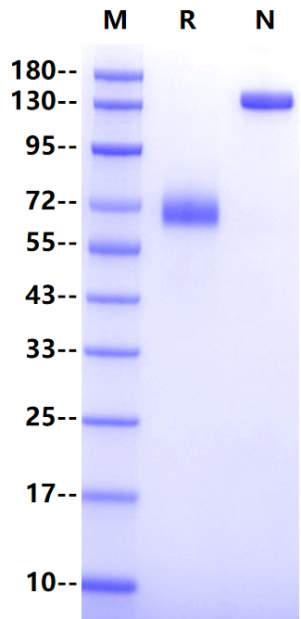1、Salih H R. et al. (2006) The role of leukemia-derived B7-H1 (PD-L1) in tumor-T-cell interactions in humans. Exp Hematol. 34(7): 888-894.
2、Wilcox R A. et al. (2009) B7-H1 (PD-L1, CD274) suppresses host immunity in T-cell lymphoproliferative disorders. Blood. 114(10): 2149-2158.
3、Ruggiero A. et al. (2009) Crystal structure of PD-L1, a ribosome inactivating protein from Phytolacca dioica L. leaves with the property to induce DNA cleavage. Biopolymers. 91(12): 1135-1142.
Programmed death ligand 1 (PD-L1) belongs to the B7 series and is a 33-kDa type 1 transmembrane glycoprotein that contains 290 amino acids with Ig-V and IgC domains in its extracellular region. PD-L1 expression can be detected on hematopoietic cells including T cells, B cells, macrophages, dendritic cells (DCs), and mast cells, and non-hematopoietic healthy tissue cells including vascular endothelial cells, keratinocytes, pancreatic islet cells, astrocytes, placenta syncytiotrophoblast cells, and corneal epithelial and endothelial cells. PD-L1 is an essential immune checkpoint protein that binds to programmed death 1 (PD-1) on T-lymphocytes. Engagement of PD-1 by PD-L1 alters the activity of T cells in many ways, inhibiting T cell proliferation, survival, cytokine production, and other effector functions. T cell plays a critical role in killing cancer cells while the cancer cell exhibits immune escape by the expression of PD-L1. The binding of PD-L1 to PD-1 inhibits T cell proliferation and activity, leading to tumor immunosuppression.


Immobilized PD-1 His Tag, Mouse (Cat. No. UA010292) at 2.0μg/mL (100μL/well) can bind PD-L1/B7-H1 Fc Chimera, Mouse (Cat. No. UA010259) with EC50 of 2.18-3.03μg/ml.

Protein A Chip captured PD-L1/B7-H1 Fc Chimera, Mouse (Cat. No. UA010259), can bind PD-1 His Tag, Mouse (Cat. No. UA010292) with an affinity constant of 0.42μM as determined in SPR assay.